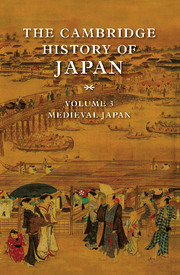Book contents
- Frontmatter
- Introduction
- 1 The Kamakura bakufu
- 2 Medieval shōen
- 3 The decline of the Kamakura bakufu
- 4 The Muromachi bakufu
- 5 Muromachi local government: shugo and kokujin
- 6 The decline of the shōen system
- 7 The medieval peasant
- 8 The growth of commerce in medieval Japan
- 9 Japan and East Asia
- 10 CULTURAL LIFE IN MEDIEVAL JAPAN
- 11 The other side of culture in medieval Japan
- 12 Buddhism in the Kamakura period
- 13 Zen and the gozan
- Works cited
- Glossary
- Index
- References
8 - The growth of commerce in medieval Japan
Published online by Cambridge University Press: 28 March 2008
- Frontmatter
- Introduction
- 1 The Kamakura bakufu
- 2 Medieval shōen
- 3 The decline of the Kamakura bakufu
- 4 The Muromachi bakufu
- 5 Muromachi local government: shugo and kokujin
- 6 The decline of the shōen system
- 7 The medieval peasant
- 8 The growth of commerce in medieval Japan
- 9 Japan and East Asia
- 10 CULTURAL LIFE IN MEDIEVAL JAPAN
- 11 The other side of culture in medieval Japan
- 12 Buddhism in the Kamakura period
- 13 Zen and the gozan
- Works cited
- Glossary
- Index
- References
Summary
Japanese society changed in many significant ways between the mid-twelfth century when the Taira were reveling in the final decades of their power and the close of the fifteenth century when the tenth Ashikaga shogun Yoshiki was ignominiously forced into a long exile. One of the most important changes was the rapid growth of commerce which affected in myriad ways both daily lives and the course of history.
This chapter describes and analyzes how market activities began and grew, leading to specialization among merchants, artisans, those engaged in transportation, and others and, as a result, raising the efficiency of both production and distribution. This chapter will pay special attention to the emergence and growth of several important economic institutions such as markets and guilds; the rise of Kyoto as the center of medieval commerce; the appearance of cities, port towns, and other urban centers and the increase in both their number and size; and other consequences of market activity and monetization that caused political and economic conflict between recipients and payers of dues and between lenders and borrowers.
- Type
- Chapter
- Information
- The Cambridge History of Japan , pp. 344 - 395Publisher: Cambridge University PressPrint publication year: 1990
References
- 2
- Cited by



